Reflective Practice and Continuing Professional Development Analysis
VerifiedAdded on 2023/01/06
|5
|771
|26
Report
AI Summary
This report delves into reflective practice and its significance in vocational teaching. It explores key aspects such as planning, the design and use of resources, meeting the needs of individual learners, and assessment strategies. The report emphasizes the benefits of reflective practice in enhancing self-awareness, developing creative skills, and encouraging active engagement in the teaching process. It discusses the importance of planning, utilizing resources like study materials and e-learning tools, and adapting teaching methods to meet diverse learning needs. Furthermore, the report highlights various assessment techniques used to evaluate learner knowledge and skills, and provides insights into areas for improvement in teaching practice. The references include books and journals that support the concepts discussed within the report.
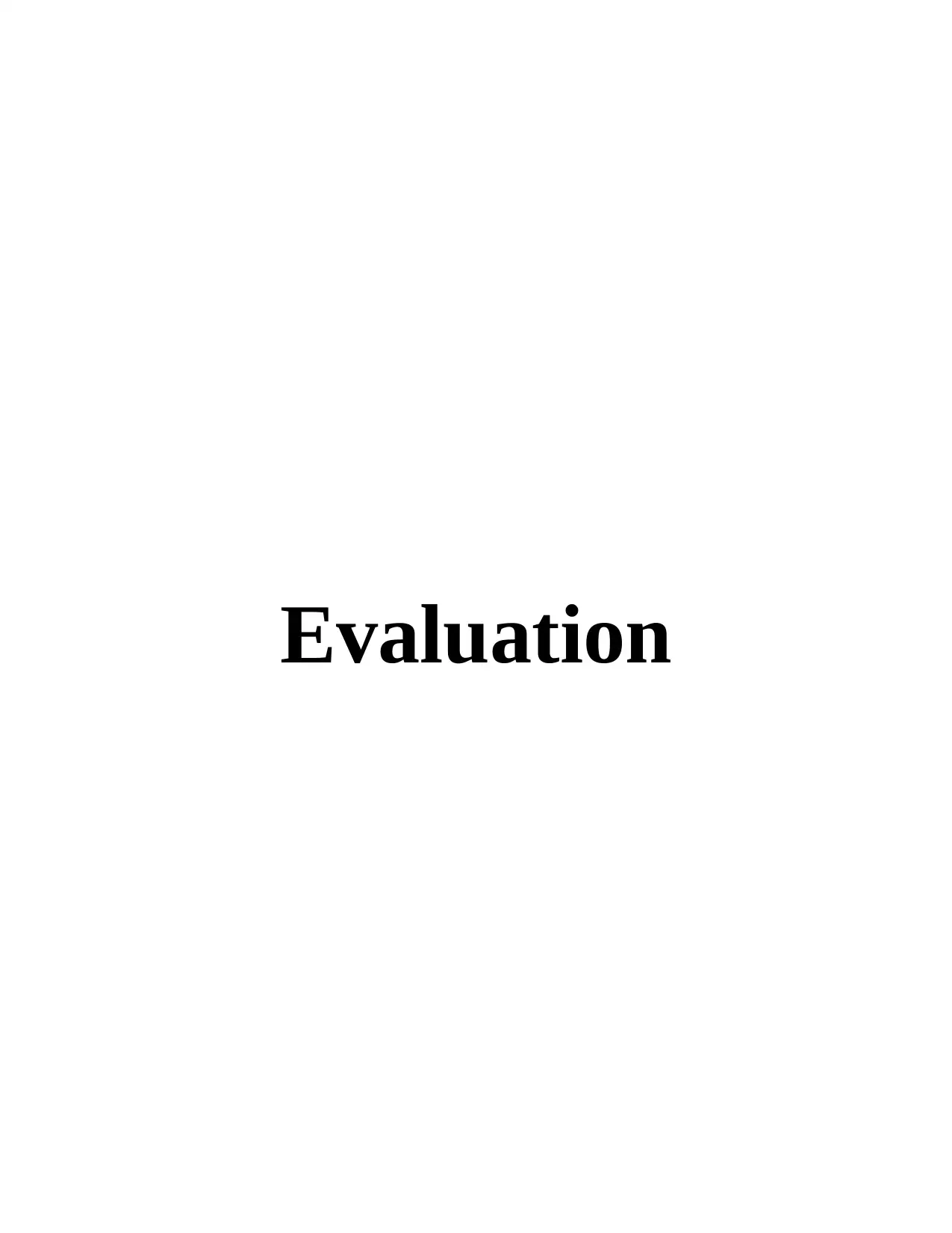
Evaluation
Paraphrase This Document
Need a fresh take? Get an instant paraphrase of this document with our AI Paraphraser
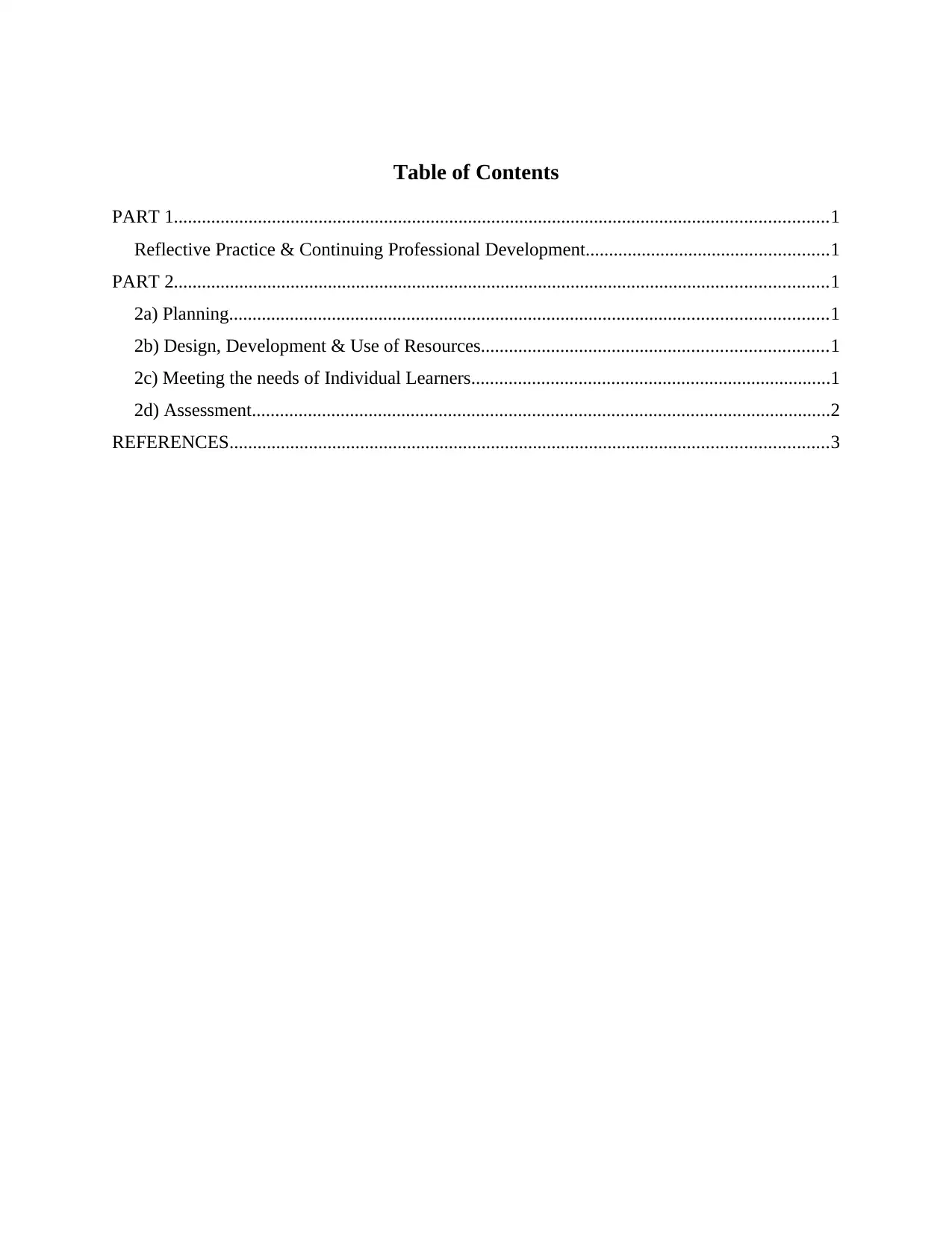
Table of Contents
PART 1............................................................................................................................................1
Reflective Practice & Continuing Professional Development....................................................1
PART 2............................................................................................................................................1
2a) Planning................................................................................................................................1
2b) Design, Development & Use of Resources..........................................................................1
2c) Meeting the needs of Individual Learners.............................................................................1
2d) Assessment............................................................................................................................2
REFERENCES................................................................................................................................3
PART 1............................................................................................................................................1
Reflective Practice & Continuing Professional Development....................................................1
PART 2............................................................................................................................................1
2a) Planning................................................................................................................................1
2b) Design, Development & Use of Resources..........................................................................1
2c) Meeting the needs of Individual Learners.............................................................................1
2d) Assessment............................................................................................................................2
REFERENCES................................................................................................................................3
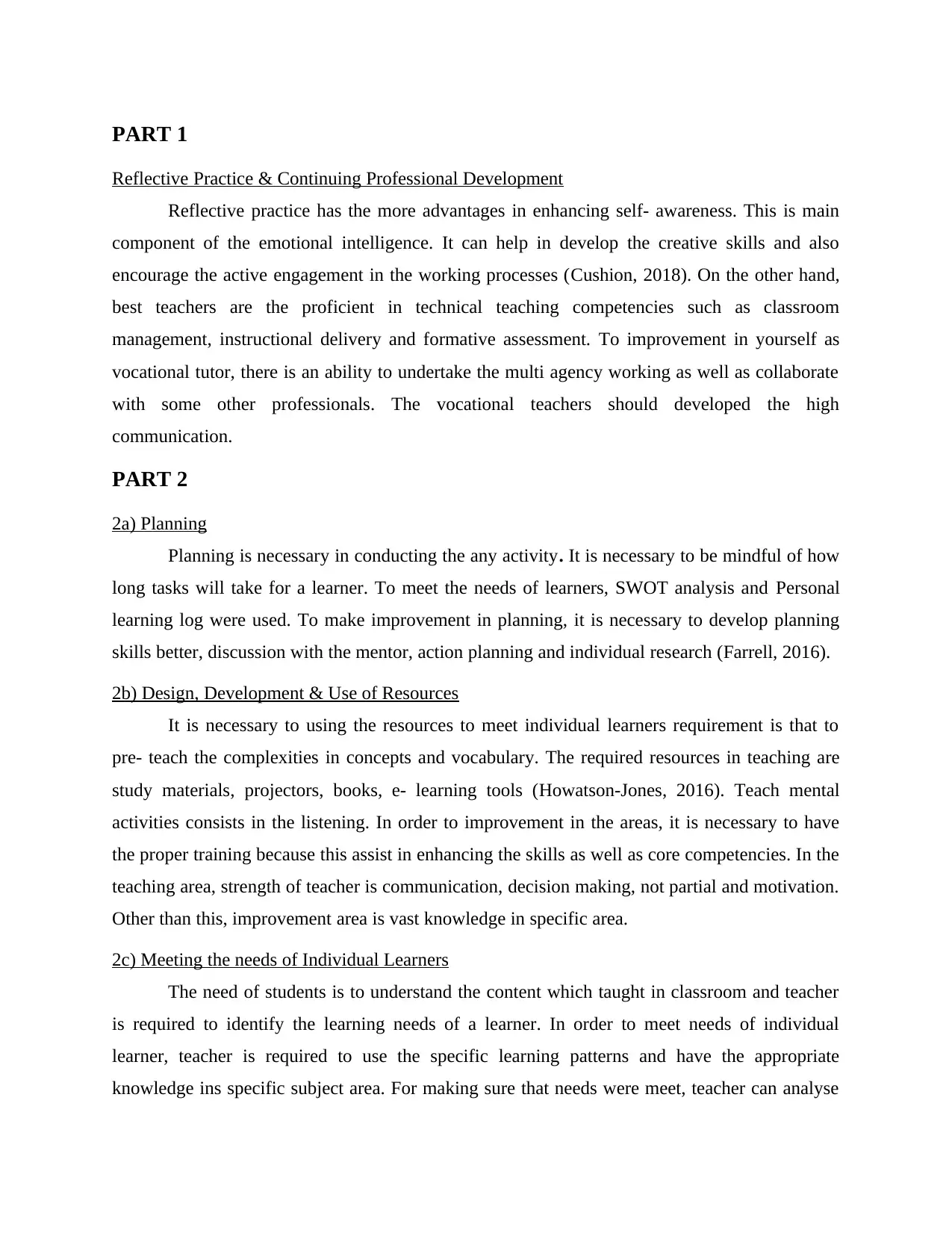
PART 1
Reflective Practice & Continuing Professional Development
Reflective practice has the more advantages in enhancing self- awareness. This is main
component of the emotional intelligence. It can help in develop the creative skills and also
encourage the active engagement in the working processes (Cushion, 2018). On the other hand,
best teachers are the proficient in technical teaching competencies such as classroom
management, instructional delivery and formative assessment. To improvement in yourself as
vocational tutor, there is an ability to undertake the multi agency working as well as collaborate
with some other professionals. The vocational teachers should developed the high
communication.
PART 2
2a) Planning
Planning is necessary in conducting the any activity. It is necessary to be mindful of how
long tasks will take for a learner. To meet the needs of learners, SWOT analysis and Personal
learning log were used. To make improvement in planning, it is necessary to develop planning
skills better, discussion with the mentor, action planning and individual research (Farrell, 2016).
2b) Design, Development & Use of Resources
It is necessary to using the resources to meet individual learners requirement is that to
pre- teach the complexities in concepts and vocabulary. The required resources in teaching are
study materials, projectors, books, e- learning tools (Howatson-Jones, 2016). Teach mental
activities consists in the listening. In order to improvement in the areas, it is necessary to have
the proper training because this assist in enhancing the skills as well as core competencies. In the
teaching area, strength of teacher is communication, decision making, not partial and motivation.
Other than this, improvement area is vast knowledge in specific area.
2c) Meeting the needs of Individual Learners
The need of students is to understand the content which taught in classroom and teacher
is required to identify the learning needs of a learner. In order to meet needs of individual
learner, teacher is required to use the specific learning patterns and have the appropriate
knowledge ins specific subject area. For making sure that needs were meet, teacher can analyse
Reflective Practice & Continuing Professional Development
Reflective practice has the more advantages in enhancing self- awareness. This is main
component of the emotional intelligence. It can help in develop the creative skills and also
encourage the active engagement in the working processes (Cushion, 2018). On the other hand,
best teachers are the proficient in technical teaching competencies such as classroom
management, instructional delivery and formative assessment. To improvement in yourself as
vocational tutor, there is an ability to undertake the multi agency working as well as collaborate
with some other professionals. The vocational teachers should developed the high
communication.
PART 2
2a) Planning
Planning is necessary in conducting the any activity. It is necessary to be mindful of how
long tasks will take for a learner. To meet the needs of learners, SWOT analysis and Personal
learning log were used. To make improvement in planning, it is necessary to develop planning
skills better, discussion with the mentor, action planning and individual research (Farrell, 2016).
2b) Design, Development & Use of Resources
It is necessary to using the resources to meet individual learners requirement is that to
pre- teach the complexities in concepts and vocabulary. The required resources in teaching are
study materials, projectors, books, e- learning tools (Howatson-Jones, 2016). Teach mental
activities consists in the listening. In order to improvement in the areas, it is necessary to have
the proper training because this assist in enhancing the skills as well as core competencies. In the
teaching area, strength of teacher is communication, decision making, not partial and motivation.
Other than this, improvement area is vast knowledge in specific area.
2c) Meeting the needs of Individual Learners
The need of students is to understand the content which taught in classroom and teacher
is required to identify the learning needs of a learner. In order to meet needs of individual
learner, teacher is required to use the specific learning patterns and have the appropriate
knowledge ins specific subject area. For making sure that needs were meet, teacher can analyse
⊘ This is a preview!⊘
Do you want full access?
Subscribe today to unlock all pages.

Trusted by 1+ million students worldwide
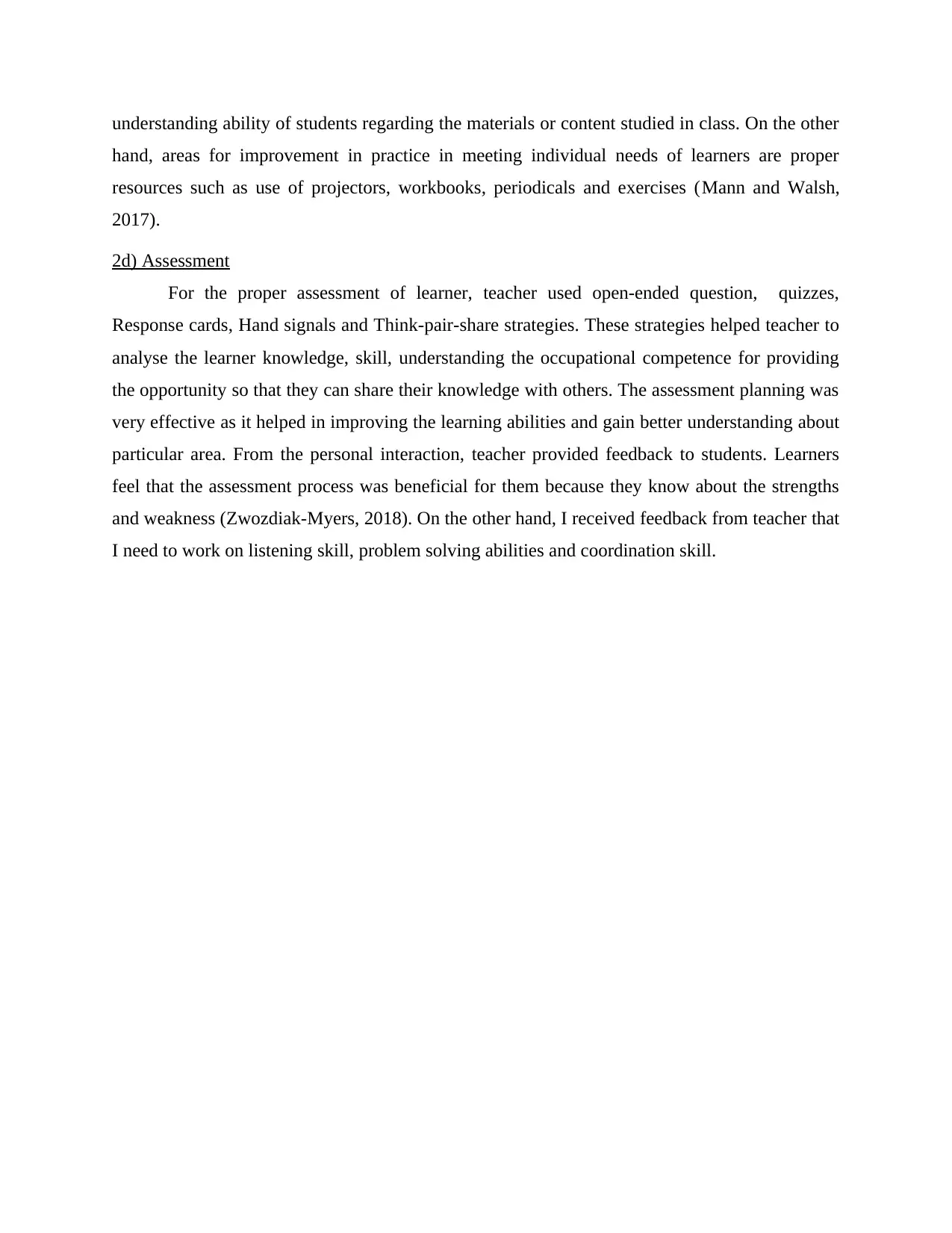
understanding ability of students regarding the materials or content studied in class. On the other
hand, areas for improvement in practice in meeting individual needs of learners are proper
resources such as use of projectors, workbooks, periodicals and exercises (Mann and Walsh,
2017).
2d) Assessment
For the proper assessment of learner, teacher used open-ended question, quizzes,
Response cards, Hand signals and Think-pair-share strategies. These strategies helped teacher to
analyse the learner knowledge, skill, understanding the occupational competence for providing
the opportunity so that they can share their knowledge with others. The assessment planning was
very effective as it helped in improving the learning abilities and gain better understanding about
particular area. From the personal interaction, teacher provided feedback to students. Learners
feel that the assessment process was beneficial for them because they know about the strengths
and weakness (Zwozdiak-Myers, 2018). On the other hand, I received feedback from teacher that
I need to work on listening skill, problem solving abilities and coordination skill.
hand, areas for improvement in practice in meeting individual needs of learners are proper
resources such as use of projectors, workbooks, periodicals and exercises (Mann and Walsh,
2017).
2d) Assessment
For the proper assessment of learner, teacher used open-ended question, quizzes,
Response cards, Hand signals and Think-pair-share strategies. These strategies helped teacher to
analyse the learner knowledge, skill, understanding the occupational competence for providing
the opportunity so that they can share their knowledge with others. The assessment planning was
very effective as it helped in improving the learning abilities and gain better understanding about
particular area. From the personal interaction, teacher provided feedback to students. Learners
feel that the assessment process was beneficial for them because they know about the strengths
and weakness (Zwozdiak-Myers, 2018). On the other hand, I received feedback from teacher that
I need to work on listening skill, problem solving abilities and coordination skill.
Paraphrase This Document
Need a fresh take? Get an instant paraphrase of this document with our AI Paraphraser
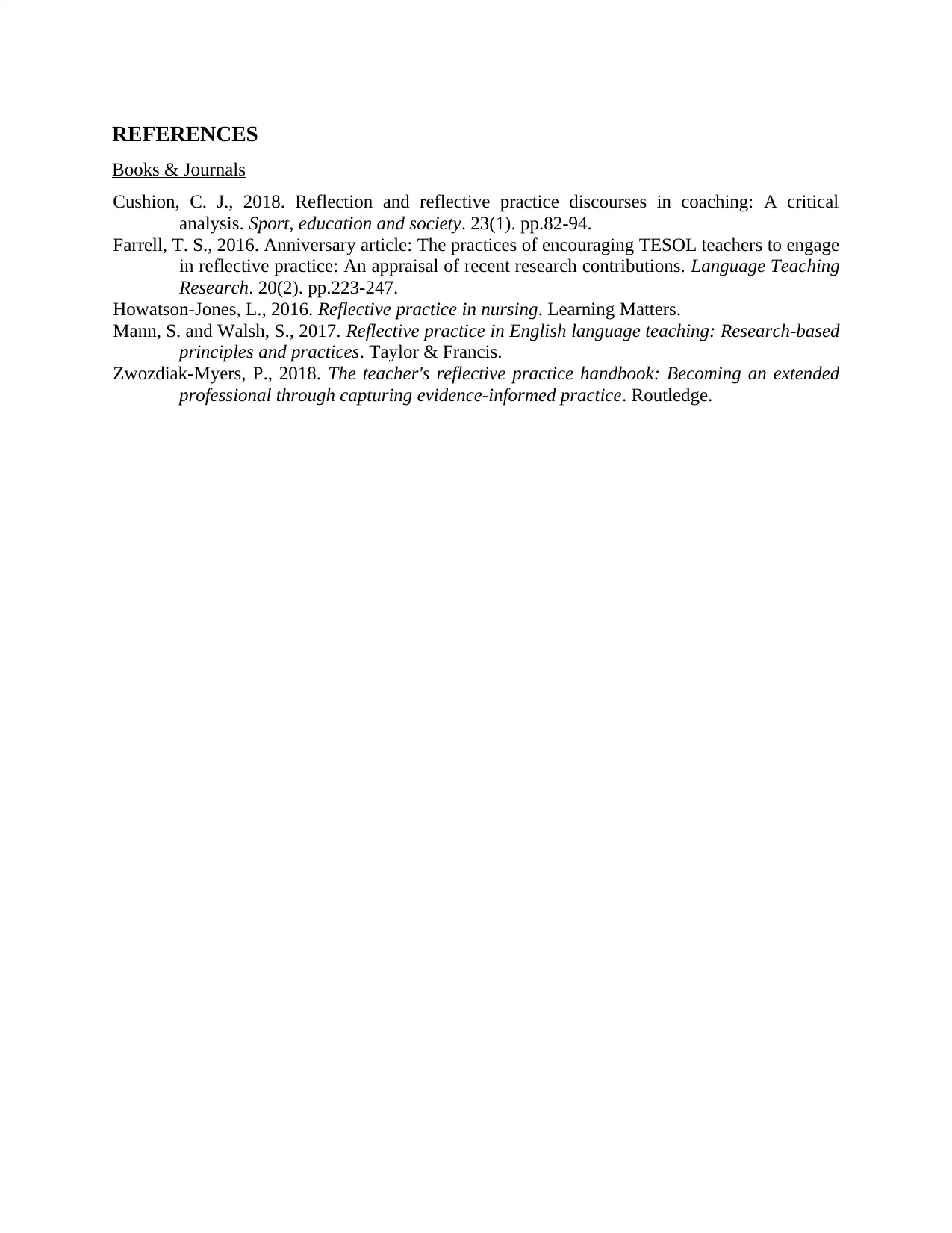
REFERENCES
Books & Journals
Cushion, C. J., 2018. Reflection and reflective practice discourses in coaching: A critical
analysis. Sport, education and society. 23(1). pp.82-94.
Farrell, T. S., 2016. Anniversary article: The practices of encouraging TESOL teachers to engage
in reflective practice: An appraisal of recent research contributions. Language Teaching
Research. 20(2). pp.223-247.
Howatson-Jones, L., 2016. Reflective practice in nursing. Learning Matters.
Mann, S. and Walsh, S., 2017. Reflective practice in English language teaching: Research-based
principles and practices. Taylor & Francis.
Zwozdiak-Myers, P., 2018. The teacher's reflective practice handbook: Becoming an extended
professional through capturing evidence-informed practice. Routledge.
Books & Journals
Cushion, C. J., 2018. Reflection and reflective practice discourses in coaching: A critical
analysis. Sport, education and society. 23(1). pp.82-94.
Farrell, T. S., 2016. Anniversary article: The practices of encouraging TESOL teachers to engage
in reflective practice: An appraisal of recent research contributions. Language Teaching
Research. 20(2). pp.223-247.
Howatson-Jones, L., 2016. Reflective practice in nursing. Learning Matters.
Mann, S. and Walsh, S., 2017. Reflective practice in English language teaching: Research-based
principles and practices. Taylor & Francis.
Zwozdiak-Myers, P., 2018. The teacher's reflective practice handbook: Becoming an extended
professional through capturing evidence-informed practice. Routledge.
1 out of 5
Related Documents
Your All-in-One AI-Powered Toolkit for Academic Success.
+13062052269
info@desklib.com
Available 24*7 on WhatsApp / Email
![[object Object]](/_next/static/media/star-bottom.7253800d.svg)
Unlock your academic potential
Copyright © 2020–2025 A2Z Services. All Rights Reserved. Developed and managed by ZUCOL.




